How to Build an Energy-Efficient Smart Kitchen and Save on Utility Bills
Saving money on utility bills while making your kitchen smarter? Sounds like a win-win. The kitchen is one of the biggest energy drains in any home, but with a few smart upgrades, you can cut waste, lower your power bill, and make cooking easier. This guide breaks down the best ways to build an energy-efficient smart kitchen, focusing on cutting utility costs while making everyday tasks more convenient.
1. Choose Energy Star Certified Appliances
Swapping out old appliances for Energy Star-certified models is one of the easiest ways to cut energy use. These appliances are built to use less electricity and water without sacrificing performance. Some models even adjust settings automatically to maximize efficiency.
What to Look for When Upgrading:
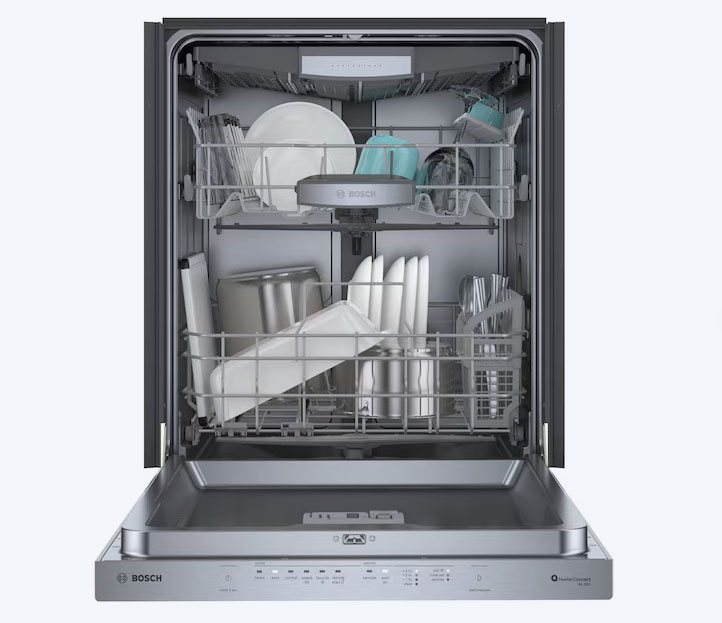
- Refrigerators
- Go for top-freezer or bottom-freezer models instead of side-by-side or French-door styles. They use up to 25% less energy.
- Skip the ice maker if possible. It adds to energy use.
- Look for smart fridges that adjust cooling based on usage patterns.
- Dishwashers
- Pick a model with an eco-mode or a short-wash cycle for light loads.
- Only run it when it’s full. Partial loads waste water and energy.
- Choose a dishwasher with soil sensors—these detect how dirty dishes are and adjust the water usage accordingly.
- Ovens & Stoves
- Induction cooktops are the most efficient option. They heat faster and use less energy than gas or electric coils.
- If you prefer gas, sealed burners improve efficiency by directing heat to the cookware instead of wasting it around the sides.
- Convection ovens use a fan to circulate heat, reducing cooking time and energy use.
Energy-efficient appliances aren’t just good for cutting utility costs. They also last longer and often perform better than older models, making them a solid investment.
2. Incorporate Smart Technology
Smart tech isn’t just about convenience—it can make a real difference in cutting utility costs. From fridges that optimize cooling to lights that turn off when no one’s around, smart devices help reduce waste and make your kitchen work more efficiently.
Smart Kitchen Upgrades That Save Energy:
- Smart Refrigerators
- Adjust cooling levels based on how often you open the door.
- Some models send alerts if the door is left open too long.
- Track food expiration dates to reduce waste.
- Smart Lighting Systems
- Motion sensor lights turn on when needed and shut off automatically.
- App-controlled LED bulbs let you dim or schedule lighting remotely.
- LED bulbs use up to 75% less energy than traditional bulbs and last much longer.
- Kitchen Automation
- Preheat your oven remotely so it’s ready when you need it—no wasted energy waiting around.
- Smart coffee makers can be scheduled to brew only when needed, reducing standby power usage.
- Smart faucets help control water flow, preventing unnecessary waste.
- Smart Plugs & Energy Monitors
- Plug non-smart appliances into smart plugs to monitor and control power usage.
- Some models track how much electricity each device uses, helping identify energy hogs.
3. Optimize Lighting
Lighting might not seem like a big energy drain, but inefficient bulbs and unnecessary usage add up. Upgrading to energy-saving options and smart lighting systems is an easy way to start cutting utility costs.
Ways to Make Kitchen Lighting More Efficient:
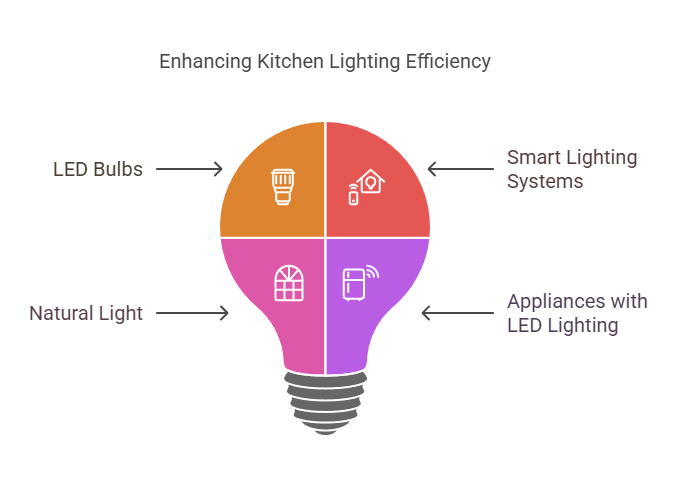
- Switch to LED Bulbs
- Use up to 75% less energy than incandescent bulbs.
- Last up to 25 times longer, so you’re not replacing them as often.
- Stay cool to the touch, reducing heat buildup in the kitchen.
- Use Smart Lighting Systems
- Motion-activated lights only turn on when needed, ideal for under-cabinet or pantry lighting.
- App-controlled bulbs let you dim or schedule lights from your phone.
- Voice-activated controls (via Alexa, Google Home, etc.) let you turn lights on or off hands-free.
- Take Advantage of Natural Light
- Use light-colored curtains or blinds to reflect natural light.
- Arrange kitchen workspaces near windows to cut down on daytime lighting use.
- Choose Appliances with Built-in LED Lighting
- Many modern fridges, ovens, and range hoods now come with LED lighting for better efficiency.
Reducing energy waste in your kitchen lighting doesn’t require major changes. Just swapping bulbs and setting up smart controls can make a noticeable difference.
4. Implement Energy-Saving Practices
Even with energy-efficient appliances and smart lighting, the way you use your kitchen plays a big role in cutting utility costs. Small habit changes can lead to noticeable savings over time.
Everyday Habits to Reduce Energy Use:
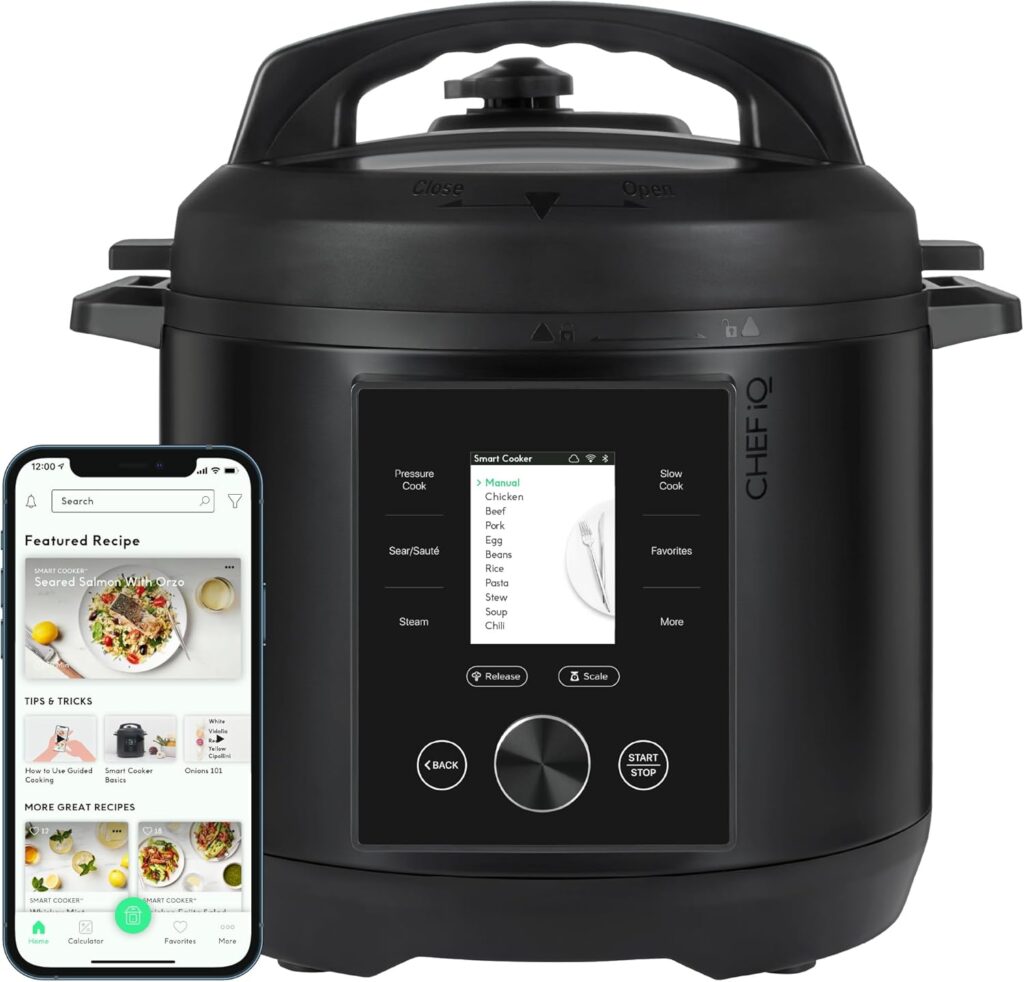
- Cook Smarter
- Cover pots and pans to trap heat and cook food faster.
- Use the right-sized burner for your pot—small pots on big burners waste heat.
- Preheat only when necessary—most modern ovens reach the right temperature quickly.
- Use Small Appliances Instead of the Oven
- Microwaves, toaster ovens, and air fryers use far less energy than a full-sized oven for small meals.
- A slow cooker or pressure cooker can cook meals efficiently with minimal electricity.
- Cut Down on Standby Power
- Unplug appliances like toasters and coffee makers when not in use.
- Use smart plugs to shut off power to multiple devices with one switch.
- Be Smart About Water Use
- Only run the dishwasher when full—each cycle uses a set amount of water and energy.
- Use cold water for rinsing dishes and avoid pre-rinsing if your dishwasher has a soil sensor.
- Fix leaky faucets—even a slow drip can waste gallons of water over time.
- Keep Appliances Clean for Maximum Efficiency
- Refrigerator coils collect dust, making the fridge work harder—clean them every six months.
- Keep oven and stovetop reflectors clean to help distribute heat more effectively.
- Descale coffee makers and kettles to remove mineral buildup, which can reduce efficiency.
Many of these changes require zero investment, just a shift in habits.
5. Utilize Smart Home Integration
A smart kitchen works even better when it’s connected to a larger smart home system. Syncing appliances and devices can optimize energy use, reduce waste, and make everyday tasks easier.
How to Integrate Smart Kitchen Tech for Maximum Savings:

- Sync Kitchen Appliances with a Smart Thermostat
- Smart thermostats adjust heating and cooling based on kitchen activity. If you’re cooking, it can lower the heat to compensate for the extra warmth.
- Some models allow you to set custom temperature schedules based on when you’re home or away.
- Use a Smart Home Hub for Automation
- Connect all smart appliances and devices to a single hub (like Google Nest or Amazon Echo) to manage everything from one place.
- Set up custom routines—for example, turning off kitchen lights and small appliances when leaving the house.
- Pair Smart Outlets with Voice Assistants
- Control older appliances with voice commands.
- Schedule power to cut off at night, preventing phantom energy drain.
- Track Energy Use with Smart Monitors
- Smart meters and energy monitors provide real-time data on power consumption.
- Identify energy-hogging devices and adjust usage accordingly.
Smart home integration takes the guesswork out of cutting utility costs. Once everything is connected, you can monitor and control your kitchen’s energy use with ease.
6. Consider Sustainable Materials
Building an energy-efficient smart kitchen isn’t just about appliances and gadgets. The materials you choose for countertops, cabinets, and even flooring can help with insulation, durability, and overall energy savings.
Best Sustainable Materials for an Energy-Efficient Kitchen:
- Eco-Friendly Countertops
- Recycled glass countertops are stylish, durable, and made from repurposed materials.
- Bamboo and reclaimed wood are sustainable alternatives to traditional stone or laminate.
- Energy-Efficient Cabinetry
- Choose FSC-certified wood for cabinets, ensuring the wood comes from responsibly managed forests.
- Low-VOC finishes reduce indoor air pollution while improving durability.
- Insulated Windows and Doors
- Double-pane or triple-pane windows keep heat in during winter and out during summer.
- If replacing windows isn’t an option, thermal curtains or window films help insulate the kitchen.
- Sustainable Flooring Options
- Cork and bamboo are durable, renewable, and naturally resistant to mold and mildew.
- Recycled tile made from glass or ceramic offers an eco-friendly, low-maintenance option.
Upgrading to sustainable materials isn’t just about cutting utility costs—it also improves durability and adds long-term value to your kitchen.
7. Monitor and Manage Energy Use
Even with all the best upgrades, keeping an eye on your kitchen’s energy use is key to cutting utility costs. Smart monitoring tools can help track power consumption and show where small changes can make a big difference.
Tools to Track and Reduce Energy Use:
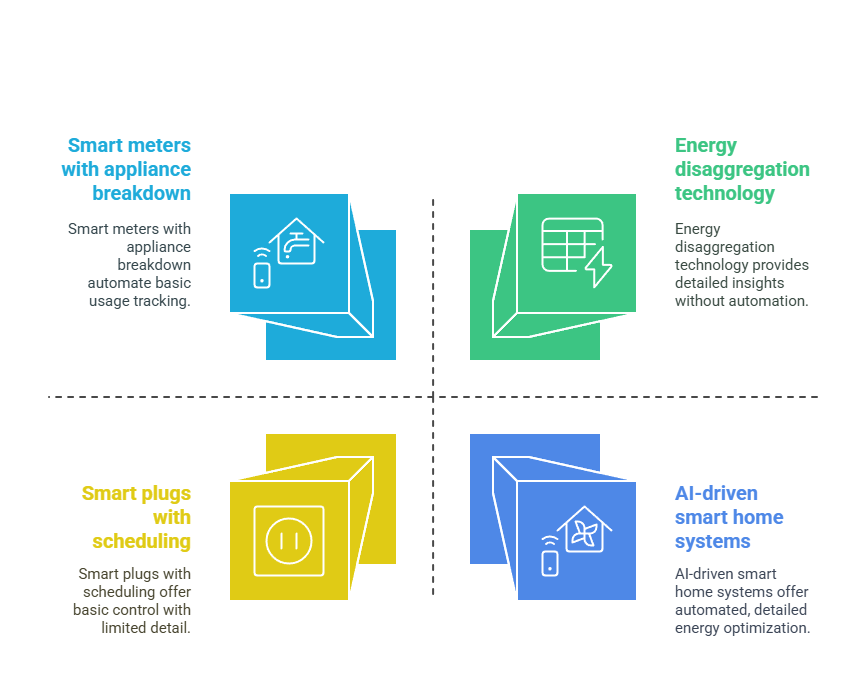
- Smart Meters
- Provide real-time updates on electricity use, helping spot energy-wasting habits.
- Some models can break down usage by appliance, showing which ones are the biggest energy hogs.
- Energy Disaggregation Technology
- Separates your total energy use by device, so you can see exactly how much power each appliance is using.
- Helps decide where an upgrade will make the biggest impact on savings.
- Smart Plugs with Energy Monitoring
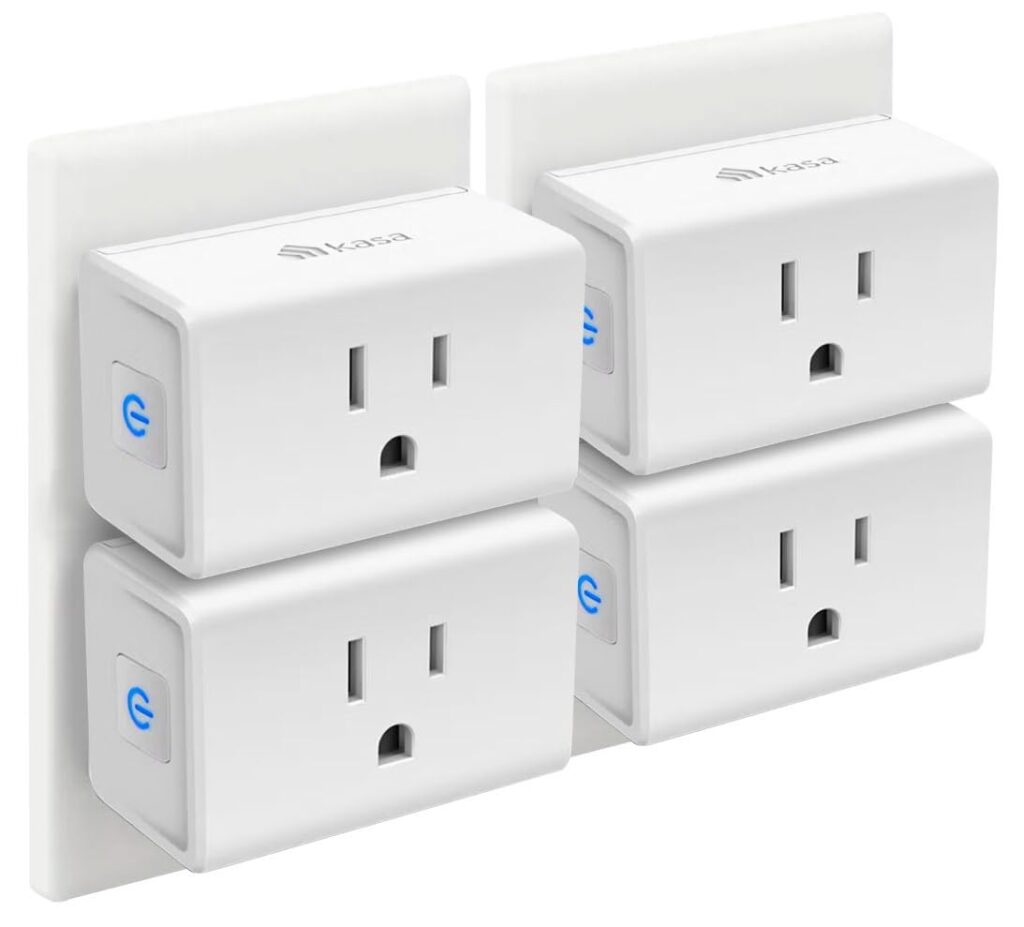
- Track how much power individual appliances are drawing.
- Set schedules to turn off devices when they’re not in use.
- Real-Time Recommendations from Smart Home Systems
- Some smart hubs suggest ways to optimize energy use, like adjusting appliance schedules or identifying inefficient devices.
- AI-driven platforms can automatically adjust settings to reduce waste.
Regularly checking energy data helps fine-tune efficiency efforts. A small tweak—like running the dishwasher at off-peak hours or adjusting the fridge temperature—can add up to real savings.
Final Thoughts
An energy-efficient smart kitchen isn’t just about buying high-tech appliances—it’s about making smart choices in how you cook, clean, and manage energy.
Quick Recap of the Best Ways to Start Cutting Utility Costs:
Upgrade to Energy Star appliances for better efficiency.
Use smart lighting and automation to reduce wasted electricity.
Adopt energy-saving habits like cooking with lids and running full loads in the dishwasher.
Integrate smart home tech to optimize and monitor usage.
Choose sustainable materials that improve insulation and durability.
Track energy use with smart meters and monitoring tools.
With these strategies, you can create a kitchen that’s not only smarter but also significantly more energy-efficient—saving money every month while reducing your carbon footprint.
FAQ: Energy-Efficient Smart Kitchen & Cutting Utility Costs
1. How much can I really save by making my kitchen more energy-efficient?
The amount varies based on the upgrades you make, but homeowners who switch to Energy Star appliances, LED lighting, and smart home automation can reduce kitchen energy use by up to 30%. Simple habit changes, like only running full dishwasher loads and using smaller appliances for quick meals, can lead to even more savings over time.
2. What are the best smart devices for cutting utility costs in the kitchen?
Smart refrigerators, dishwashers, lighting systems, and thermostats make the biggest impact. Smart plugs help monitor energy use, and motion sensor lights prevent wasted electricity. A smart home hub can link everything together for maximum efficiency.
3. Are induction cooktops really more energy-efficient than gas or electric stoves?
Yes. Induction cooktops use up to 10% less energy than standard electric stoves and are nearly twice as efficient as gas stoves. They heat up faster and transfer energy directly to cookware, meaning less wasted heat.
4. What’s the easiest way to start making my kitchen more energy-efficient?
The fastest, most affordable upgrades include:
- Replacing incandescent bulbs with LED lights
- Using smart plugs to cut off standby power
- Running appliances like dishwashers and washing machines during off-peak hours
- Cleaning refrigerator coils and keeping freezer compartments full to maintain efficiency
5. Do I need a full kitchen remodel to see savings?
Not at all. You can start cutting utility costs with small, low-cost changes like adjusting fridge temperatures, using energy-efficient cooking techniques, and installing smart power strips. Over time, upgrading to better appliances and integrating smart home technology will lead to even bigger savings.

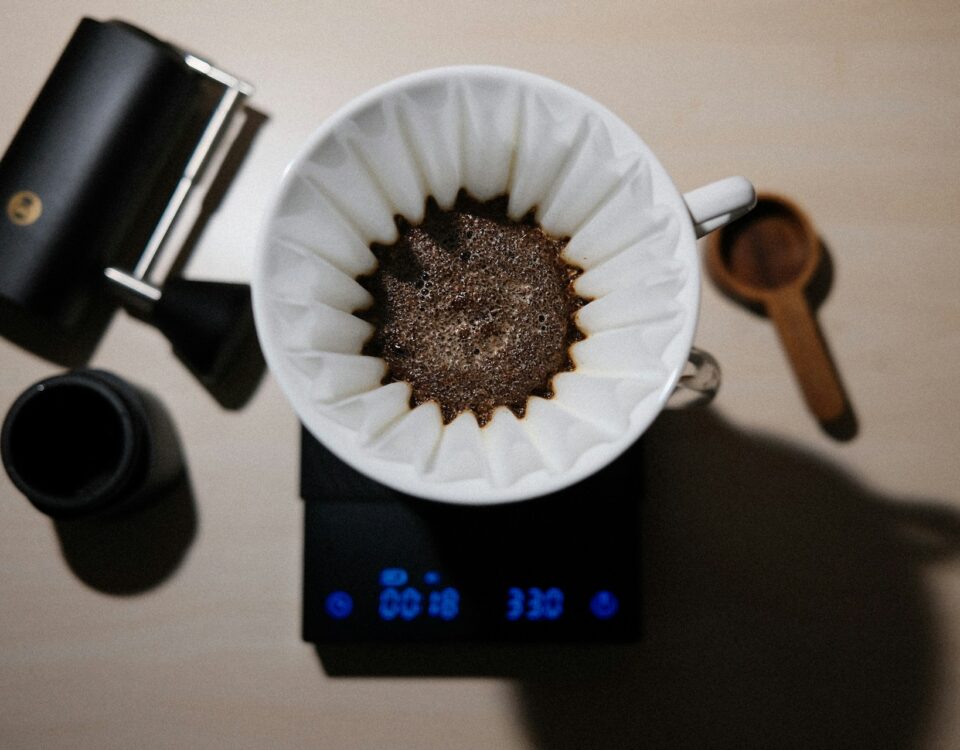
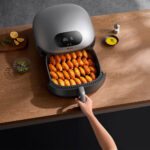

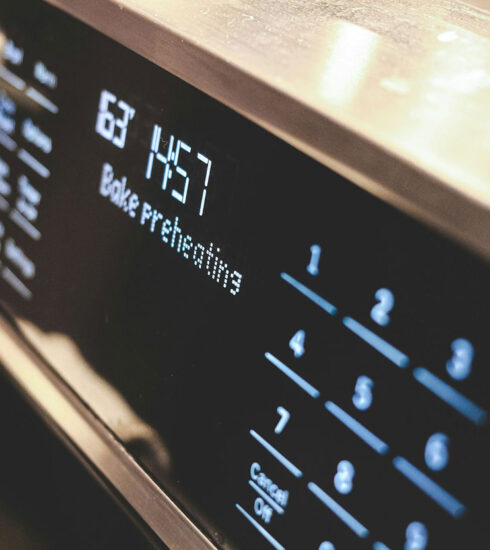

4 Comments
Best Smart Microwaves for an Energy Efficient Kitchen
2 weeks ago[…] ENERGY STAR® certified appliances use up to 30% less power than older models. […]
DIY Kitchen Tech: Kitchen Improvements on a Budget
2 weeks ago[…] Are energy savings a priority? […]
Inexpensive Kitchen Upgrades for 2025: Affordable Ideas
1 week ago[…] Not ready to invest in a new fridge or stove? No problem. Here are a few budget-friendly ways to make your kitchen more energy-efficient: […]
The Smart Kitchen Buyer’s Guide: Home Automation Kitchen Tips
1 week ago[…] Energy-efficient (e.g., dishwashers that adjust water use, fridges that optimize cooling) […]